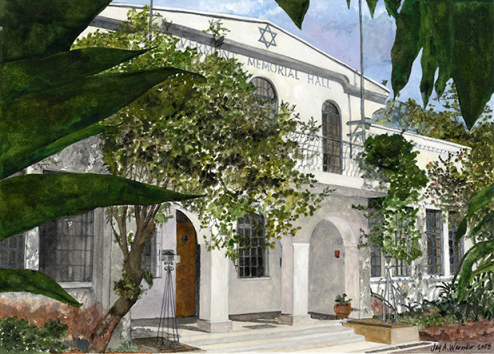View entry
Name: VERMONT, Simon

Birth Date: 1874
Death Date: 27 Jan 1937 Nairobi
First Date: before 1914
Last Date: 1937
Area: Nairobi
Book Reference: Barnes, Glimpses
War Service: East African units, KAR
General Information:
Nairobi South cemetery - Simon Vermont, born 1874, died 27 Jan 1937
Glimpses - EA Standard 20 May 1938 - His Worship the Mayor of Nairobi and Mrs Mortimer, members of the clergy of different denominations and a large and representative gathering were present at the official opening of the Vermont Memorial Hall, Kirk Road, Nairobi, by His Excellency the Governor yesterday morning. …….. His Excellency and Lady Brooke-Popham were welcomed by Mr E. Ruben, Chairman of the Committee and a Past President of the Hebrew Congregation. "Thanks to the generosity of the members of the Jewish community of Nairobi and in particular to the late Mr Simon Vermont after whom this Hall is named," said Mr Ruben, "this building has become possible ……… This Hall is intended primarily for the cultural and physical development of our community, but we welcome all peoples, irrespective of their faith."
Ancestry Family Tree (very sparse) says he had a dau. Janet Kibwona
https://www.africansynagogues.org/html/countries/kenya/kenya2.html The idea to build a social hall for the Nairobi Hebrew Congregation dates to 1934, although it was not realized until 1938. A plot of land was initially provided by the colonial government, but the funds necessary to construct a building on that site could not be raised, and the project abandoned. Instead, a few years later the estate of Simon Vermont, who one of the earliest settlers in Nairobi, under the leadership of his brother Isaac and his wife, generously donated money to build the hall on the existing synagogue campus. Work began in 1937, and it was completed the next year. For nearly eight decades the attractive structure has served as a social hall, kitchen, gift shop, gallery, and administrative space for the Nairobi Hebrew Congregation. It was designed by local architect Leon (Yehuda) Zuckerman, son of early Zionist immigrants to Palestine who had immigrated to Kenya in the late 1920s.
The dedication ceremony for Vermont Hall on May 20, 1938 was a grand and happy event, with several invited guests joining the Jewish community. His Worship the Mayor of Nairobi and his wife Mrs. Mortimer and clergy representing various denominations in town were in attendance along with His Excellency the Governor, who was presented a key to the building. During the event, the leader of the Nairobi Hebrew Congregation made note that Vermont Hall, being opened a quarter a century since the dedication of the synagogue, had been built “primarily for the cultural and physical development of our community by we welcome peoples irrespective of their faiths.” His Excellency the Governor in his remarks mentioned that the Jews of Nairobi had made considerable contributions to the Nairobi and the rest of the Free Colony of Kenya, including turning what was once unsightly swampland in Nairobi into a beautiful synagogue campus.
During World War II, Vermont Hall was requisitioned by the British colonial government for military purposes. The Jews were paid rent for the hall during this period, although the British denied them use of the building. It was then that Zuckerman designed and with his own funds had built another space on the synagogue campus to fill in temporarily. In time this structure became the synagogue’s library. Nairobi Hebrew Congregation regained control of the hall in 1948, although the military continued to have a presence on the synagogue campus until 1951.
In the late 1980s and early 1990s, Vermont Hall was renovated under the leadership of local Jewish architect Heini Lustman. Whereas the original building was made up of a tripartite design with a central wider and higher rectangular block capped with tall flag poles that were flanked with lower and less wide rectangular block side wings (with three metal casement windows each) set back, work was carried out to alter the aesthetic of the building. Whereas the original design was streamlined and Modern with its simple geometry and limited and restrained ornament, what resulted was a building that now seemed more traditional and historically-based. A new central façade, veneered in white stucco, featuring a low pediment, shallow portico with three rounded arches and an aggregate floor detailed with a Star of David, and a wrought iron balcony at the porch were added, compromising the original design. Set at the top of the pediment was a Star of David. During this period, the existing interior spaces of Vermont Hall, including the large social gathering hall with hardwood floors, were refurbished and updated. To the rear of the building, the same pediment was added, and here the building features a covered wrap around porch.
The dedication ceremony for Vermont Hall on May 20, 1938 was a grand and happy event, with several invited guests joining the Jewish community. His Worship the Mayor of Nairobi and his wife Mrs. Mortimer and clergy representing various denominations in town were in attendance along with His Excellency the Governor, who was presented a key to the building. During the event, the leader of the Nairobi Hebrew Congregation made note that Vermont Hall, being opened a quarter a century since the dedication of the synagogue, had been built “primarily for the cultural and physical development of our community by we welcome peoples irrespective of their faiths.” His Excellency the Governor in his remarks mentioned that the Jews of Nairobi had made considerable contributions to the Nairobi and the rest of the Free Colony of Kenya, including turning what was once unsightly swampland in Nairobi into a beautiful synagogue campus.
During World War II, Vermont Hall was requisitioned by the British colonial government for military purposes. The Jews were paid rent for the hall during this period, although the British denied them use of the building. It was then that Zuckerman designed and with his own funds had built another space on the synagogue campus to fill in temporarily. In time this structure became the synagogue’s library. Nairobi Hebrew Congregation regained control of the hall in 1948, although the military continued to have a presence on the synagogue campus until 1951.
In the late 1980s and early 1990s, Vermont Hall was renovated under the leadership of local Jewish architect Heini Lustman. Whereas the original building was made up of a tripartite design with a central wider and higher rectangular block capped with tall flag poles that were flanked with lower and less wide rectangular block side wings (with three metal casement windows each) set back, work was carried out to alter the aesthetic of the building. Whereas the original design was streamlined and Modern with its simple geometry and limited and restrained ornament, what resulted was a building that now seemed more traditional and historically-based. A new central façade, veneered in white stucco, featuring a low pediment, shallow portico with three rounded arches and an aggregate floor detailed with a Star of David, and a wrought iron balcony at the porch were added, compromising the original design. Set at the top of the pediment was a Star of David. During this period, the existing interior spaces of Vermont Hall, including the large social gathering hall with hardwood floors, were refurbished and updated. To the rear of the building, the same pediment was added, and here the building features a covered wrap around porch.
